To’ak Chocolate: If Not The Best Chocolate In The World, It’s A Worthy Contender (Also For The Most Expensive!)
by Ken Gargett
If I did not know better, I’d swear my nephew, whom I love dearly, was adopted. Aside from supporting some extremely dubious sporting teams (I suspect more to annoy the other members of the family than through any genuine devotion), worst of all the kid does not like chocolate.
Who does not like chocolate?
Bars of chocolate, chocolate milkshakes, chocolate ice cream, chocolate cake, Easter eggs . . . you name it. As the great Dave Barry said, “Your hand and your mouth agreed many years ago that, as far as chocolate is concerned, there is no need to involve your brain.”
Perhaps we have an exception here.
Not all chocolate is created equal. We are all familiar with the popular mass-produced brands and producers. Nothing wrong with them, until you try the real stuff. Valrhona is perhaps the most well known of the great chocolate producers, while here in Australia we have makers such as Bahen & Co. Specialist and impressive chocolatiers have sprung up in many places.
So who does make the best chocolate in the world and where does it come from? In truth, you’ll probably get as many opinions as people you ask. You’ve as much chance of identifying the world’s best wine or best whisky or best rock and roll singer or even best watchmaker. The fun is in the research!
The more I looked into the story of great chocolate, the more one name kept popping up. So I had little choice but to do a deep dive into great chocolate. The name that kept coming up was To’ak from Ecuador, so that seemed like a sensible place to start.
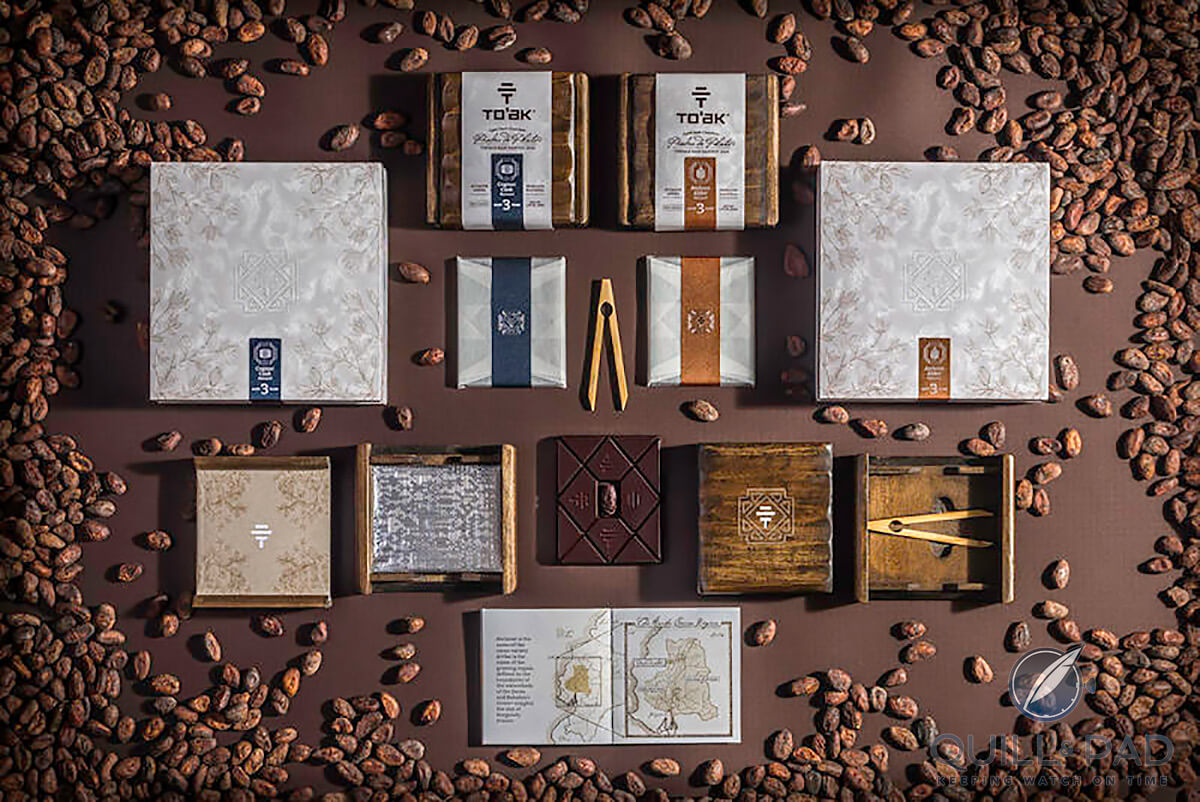
To’ak chocolate (photo courtesy To’ak)
Does To’ak make the best chocolate in the world? As I said, that will come down to personal judgements, but there is no doubt that it is a serious contender. To’ak has no qualms about announcing itself as offering the most expensive chocolate in the world, although it prefers to think of it as the world’s most valuable.
But before we head down the To’ak road, how is chocolate made and from where does it originate? Not the mass-produced stuff, but great chocolate.
The origins of chocolate
While sources vary widely, chocolate seems to date back 5,300 years in Ecuador, but is thought to have first been widely used culturally in Central America. In Mexico, cacao was supposedly a gift from the god of wisdom, Quetzalcoatl (which I am proud to say was a name known to my spellcheck). The seeds of the cacao tree were only made into a drink at this time, supposedly for use as an aphrodisiac and as currency.
It is believed that the first European to encounter chocolate was Christopher Columbus in 1502, though it made little impact on him and it is believed he had no idea that it could be consumed.
Chocolate reached Europe via the Spanish conquest but was still very bitter thanks to the manner in which it was made. Honey and spices were often added to make it more palatable.
Over the years, the process of production was refined – salts added to reduce bitterness, the cacao butter removed to ease production, machine presses, the addition of powdered milk, and more. These days, around two-thirds of cacao is produced in West Africa, notably the Ivory Coast.
Around five percent of the world’s best chocolate is labelled as “Fine Aroma.” And at that top end, Ecuador produces around 60 percent of that five percent. Not surprising, fine Ecuadorean chocolate is highly sought after by chocolatiers around the globe.
First, however, you start with the cacao tree. Some producers grow and harvest their own; others do not have that luxury and need to source fruit, often from a very long way away. Those who do work their own insist that is the only way; others will disagree.
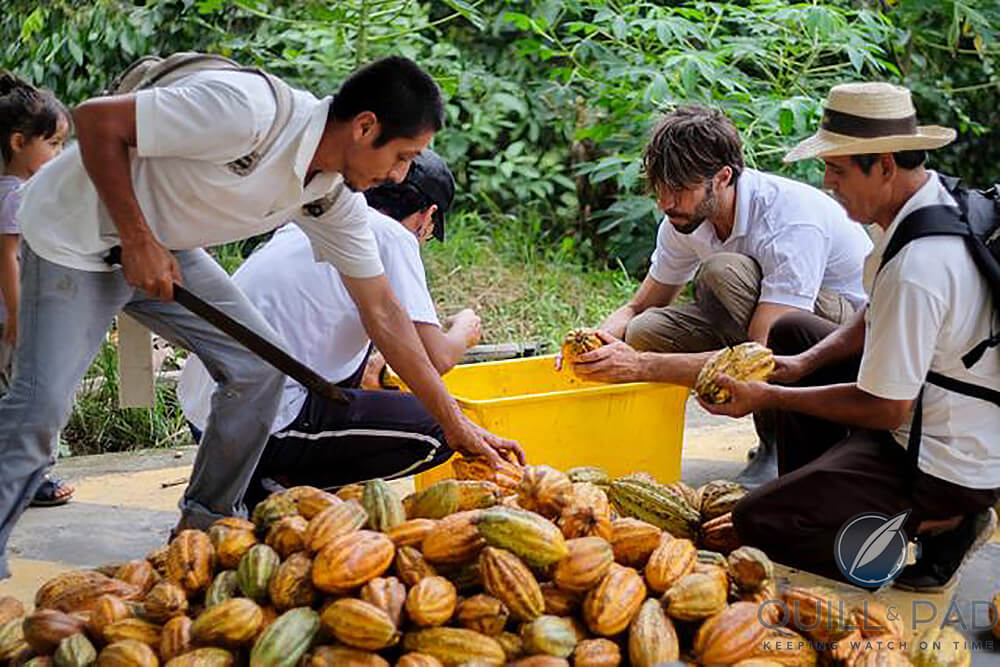
Jerry Toth checking cacao pods in Ecuador (photo courtesy To’ak)
Jerry Toth of To’ak compares the care of the trees as akin to viticulture in Burgundy – there are few more sacred tasks.
A healthy tree is essential. Flavor, yield, and variety are key. The To’ak preference is for the Nacional Cacao tree, once thought to be extinct. These days, many Nacional trees have been interbred, so care with selection is necessary.
There is evidence of the Nacional as far back as 5,300 years ago; it has long been considered the superior tree. Then, in 1916, this variety was devastated by an outbreak of “witches’ broom disease” and also “frosty pod disease” (say whatever you will about the South Americans, but they know how to name a disease). Hence began the hybridization via introduction of other varieties.
In 2009, the INIAP (Ecuador’s agricultural research institute) tested DNA samples from 11,000 cacao trees. Only six trees were found to be pure Nacional, but at least we had confirmation that the Nacional was not extinct.
A few years later, in 2013, To’ak found a grove of another 16 Nacional Cacao trees between 100 and 120 years of age. This was in the valley of Piedra de Plata, which is located in the mountains of the Arriba region. DNA proved nine of these to be pure. Fifteen trees might not be enough on which to base an industry, but it is a start. To’ak has worked closely with the authorities and is involved with the conservation of these trees.
The name “Arriba” also has a nice story behind it. A few centuries ago, a Swiss chocolatier was looking to source supplies and met some local porters on the Guayas River. When the porters opened their bags, a wonderful floral aroma emerged. The chocolatier was enamored by it and asked where the beans had been sourced. The natives replied, “arriba,” pointing back up the river – effectively meaning “up river.” The chocolatier misunderstood, believing that Arriba was the region. And hence, it became so.
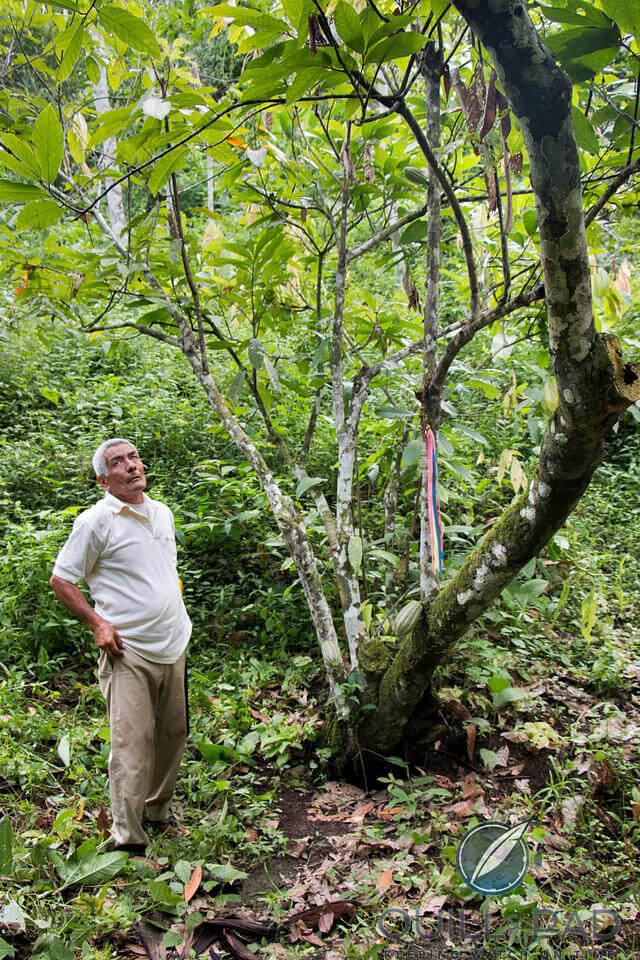
Nacional Cacao tree in Ecuador (photo courtesy To’ak)
To digress, the cacao tree has a peculiarity about it. It grows flowers, and subsequently seed pods/fruit, on its trunk as well as its branches (such trees are known as cauliflory). Conventional wisdom insists that the pods from the trunk are not best used for seeds as they will, in turn, lead to lower-yielding trees, but they are fine for chocolate.
Anyway, for the next generation of trees, harvest your pods and then, with a machete, slice them open, which will reveal around 30 seeds covered in sweet white pulp. If less than 30 or so of the seeds are small, don’t plant them. Cacao trees can still grow in odd ways so if you want to be certain of replicating your tree, grafting is the only way.
The cacao tree known as CCN-51 originated from the Nacional. Developed in 1965, its advantage is “spectacular productivity,” but the disadvantage is poor flavor. The widespread cultivation of this variety opens up chocolate to a potential problem. Lack of diversity means that, should a disease strike, as we have already seen in bananas, then a worldwide shortage of cacao will occur. Better we leave the consequences of that to another time and place.
Producers like To’ak rarely grow all the cacao they need, so they source from locals. To’ak makes certain it pays well above the going rate to ensure it gets the very best. After that, it makes certain that it manages every part of the process, right through to the finish.
The cacao for To’ak’s flagship chocolates are sourced from 13 growers in Piedra de Plata, although it has released an edition sourced from heirloom Nacional Cacao trees grown in the Galapagos Islands.
Most of us, however, will not be so much interested in farming cacao trees but in the chocolate they produce: so after those seeds are removed, pulp and all, the growers ferment, dry, roast, grind, refine, and make chocolate (sounds simple).
The fermentation process – the contents of the pods are scraped out and exposed to the sun to ferment – helps break down the sugars. The beans are then dried, losing 50 percent of their weight. Most trees are lucky to give up a kilo of dried beans (I’m staggered by that).
After roasting, winnowing removes the shells, and the remaining nibs are ground to a paste by grinding. Cacao butter is released from the nib thanks to the levels of heat. Cooled and hardened, we have unsweetened chocolate.
Refining is followed by conching, where the cacao butter is distributed within the chocolate. The heat releases flavors. It was this that enabled chocolate to move from just a drink to production as bars. And all of that is an embarrassingly simplistic description of the process.
At To’ak, after the grinding has produced a 100 percent pure cacao mass, solid at room temperature, it used in the chocolate bars. For the chocolate powder that the brand also makes, a specialized grinder “pulverizes the pure cacao mass into powder.”
As for the benefits of chocolate in this form and the nutritional value – all the good things – if we start down that track, this piece will be ten times as long. Suffice to say that it is a most beneficial food as well as one that tastes truly amazing.
Back to To’ak
To’ak began in 2007 when Jerry Toth, rainforest conservationist and cacao farmer, joined forces with his partners to take chocolate to a new level.
The Bamboo House, where production was to take place, did not even have electricity when they began, so everything was done by hand. The cacao beans were roasted in an iron pot over a wood fire and then de-husked by hand, one by one. An old hand grinder was used to manually grind the beans.
Toth’s view of his work: “In ancient times, chocolate was considered sacred and noble. Then in the industrial era it was commodified and mass-produced. To’ak is working to restore chocolate to its former grandeur and push its boundaries to new horizons.” People have had less noble aims.
The name “To’ak” comes from an ancient Ecuadorean dialect, meaning “earth” and “tree,” which the team sees as the sources for all great chocolate. It also allows the team to maintain its link to what it sees as the equivalent to the French concept of terroir for wines.
People often quote percentages of cacao as some sort of mantra of quality for chocolate. To’ak doesn’t rely on this but the percentages for its various chocolates run from 73 percent into the low 80s (basic milk chocolate needs only to be 10 percent).
What the percentages actually advise is more an indicator to the levels of bitterness the chocolate will exhibit. The higher the percentage, the bitterer the chocolate. But there is, of course, much more to it than just that.
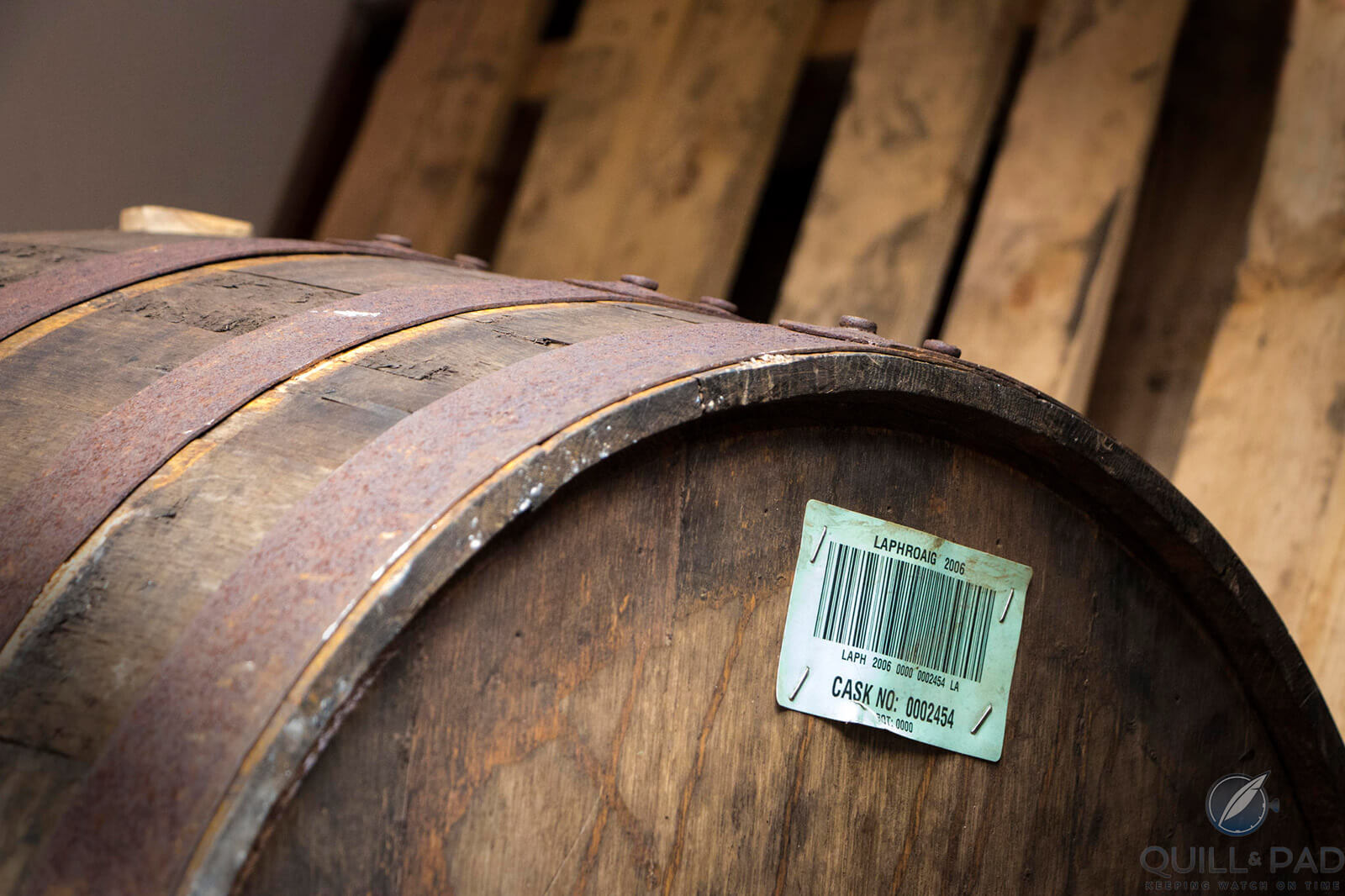
To’ak chocolate aging in a Laphroaig whisky barrel (photo courtesy To’ak)
Innovation has taken To’ak to new levels. The contribution of barrels and casks to wine and great spirits, like whiskies and rums, is well known. To’ak has adopted that with its chocolate and developed the world’s first long-term chocolate aging program, with the casks contributing to the flavors and aroma over time.
The casks used range through cognac, whisky, bourbon, sherry, tequila, Port, and Sauternes. To’ak also ages its chocolate with items such as Kampot pepper and Palo Santo (an aromatic wood believed to have healing properties).
It has also brought in the concept of vintage chocolate, which it combines with location. So you can try chocolate from a specific region and identified year. Not really what you expect from a block of choc picked up at the local servo. New horizons, indeed.
To’ak is also very proactive in promoting the consumption of chocolate in combination with wine, spirits, and even cheese. And like many of the world’s great wines, many of its editions are made in tiny quantities, sometimes as little as 150 bars for the entire “edition.” Some even less.
To’ak also focuses very much on presentation, involving local art and handcrafted wooden boxes with detailed booklets to provide all the information one could use.
Aging chocolate is a concept that To’ak has also embraced, pioneering the process in 2013. Just as barrels contribute to certain spirits and wines, so too can they influence chocolate.
Some of the flavors they have noted include vanilla, florals, spices, buttery notes, coconut, malt, nuts, and caramel. The chocolate is usually placed in the barrels in solid form, but either way, the high percentage of fat in chocolate, often referred to as cacao butter, allows the oak to impart these flavors.
To’ak neither extracts the cacao butter from the chocolate nor does it add any, but as noted it has properties that allow it to absorb flavors during this process. This is why an open bar of chocolate in the fridge or elsewhere might quickly pick up the flavors of whatever is nearest, which can be an issue.
To’ak has aged chocolate for up to four or five years so far and experimented with aromatic products that influence the final result. Cambodian Kampot pepper is an example of this. The company is still learning about these processes. They have already found that cognac casks can impart sufficient flavors within a year. Other infusions can take much longer.
So just how good is To’ak chocolate?
Is it worth the extraordinary prices asked? How good? Seriously wonderful. Worth it? A decision for every individual, but trying To’ak should surely be on every bucket list. Just accept that you will be paying hundreds of dollars for small bars of chocolate. We would never quibble about this for a glass of Domaine de la Romanée-Conti or an equivalent amount of caviar. The problem is recalibrating our perception of what we should pay for great chocolate.
As for what is available, prices, locations, consult the very informative website toakchocolate.com.
As well as 50-gram bars, To’ak also offers collections of mini-bars at three grams each to allow those interested to experience the chocolate.
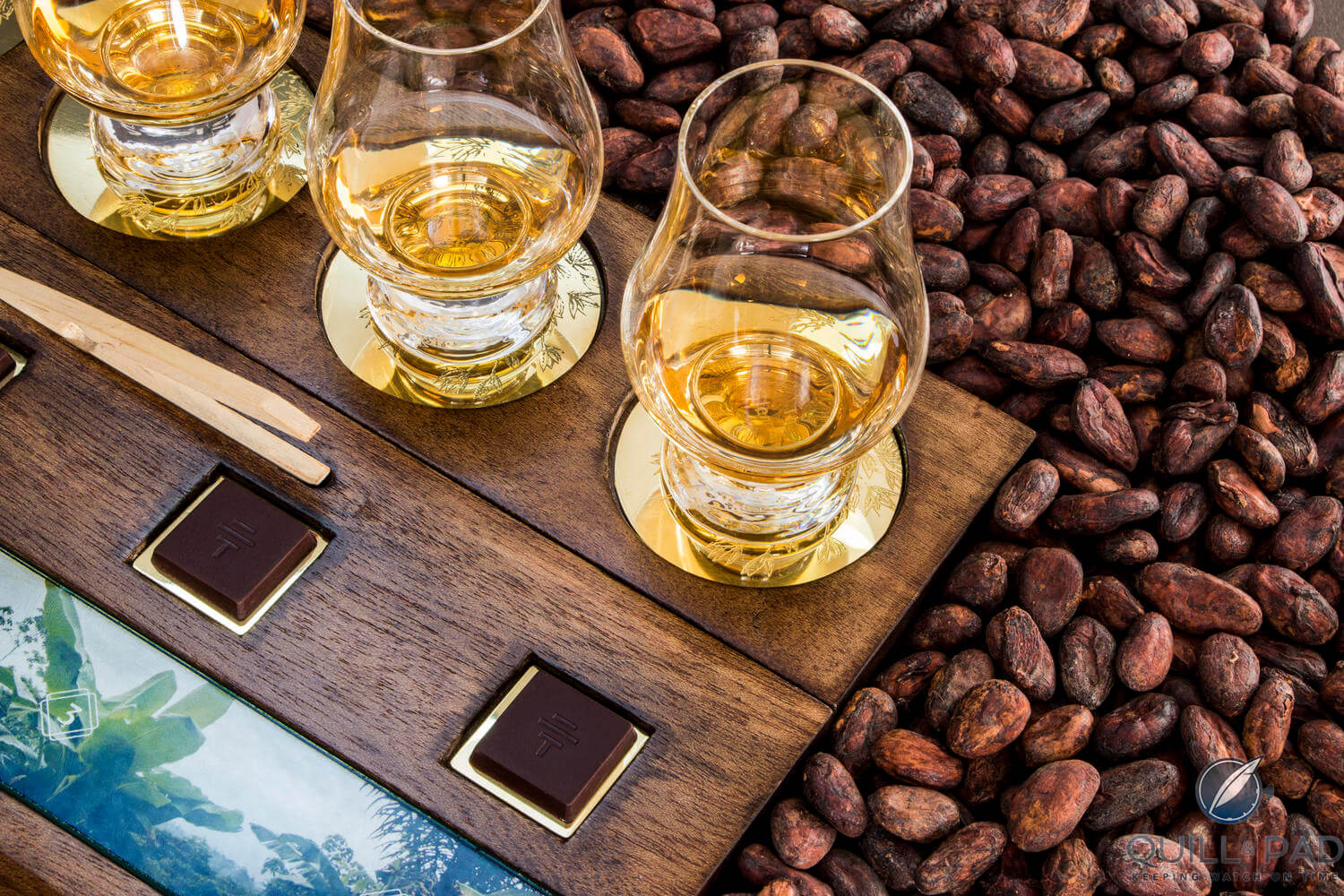
To’ak chocolates goes very well with spirits (photo courtesy To’ak)
To’ak chocolate tasting notes
3 Years Islay Cask
I will confess that, while I enjoy a wide range of whiskies, those peated beauties from the Scottish island of Islay are particular favorites. This chocolate spent three years maturing in a cask sent to To’ak from Laphroaig, one of the greatest of all Islay distilleries.
The result will change your perception of chocolate forever. Don’t look for a chocolate soaked in whisky and dominated by it. Rather, this is far more subtle. There are some peat notes with honey, caramel, hints of sea breeze, even perhaps oyster shell.
This is chocolate, but not as you know it. Add in some smoke and cassis. This is manna from heaven, or perhaps chocolate from angels.
3 Years Sauternes Cask
What is so evident with these chocolates is the incredible intensity of flavor but also how they are so amazingly well balanced. Never intrusive or jarring, no matter how powerful. And they last for a length of time that one could never envisage.
Here we have stone fruit, some of that raisiny character often found in a good fortified, spices, honey, nectarines, and apricots, a hint of cassis. Glorious.
5 Years Andean Alder
To’ak aged its original Andean Alder chocolate from 2014 for four years. Has any chocolate ever been aged for that period? This release saw an extra year.
The alder is a tree related to the birch family. Its wood has been used to smoke seafood and coffee and even in the manufacture of electric guitars. It forms the basis of the foundations of Venice.
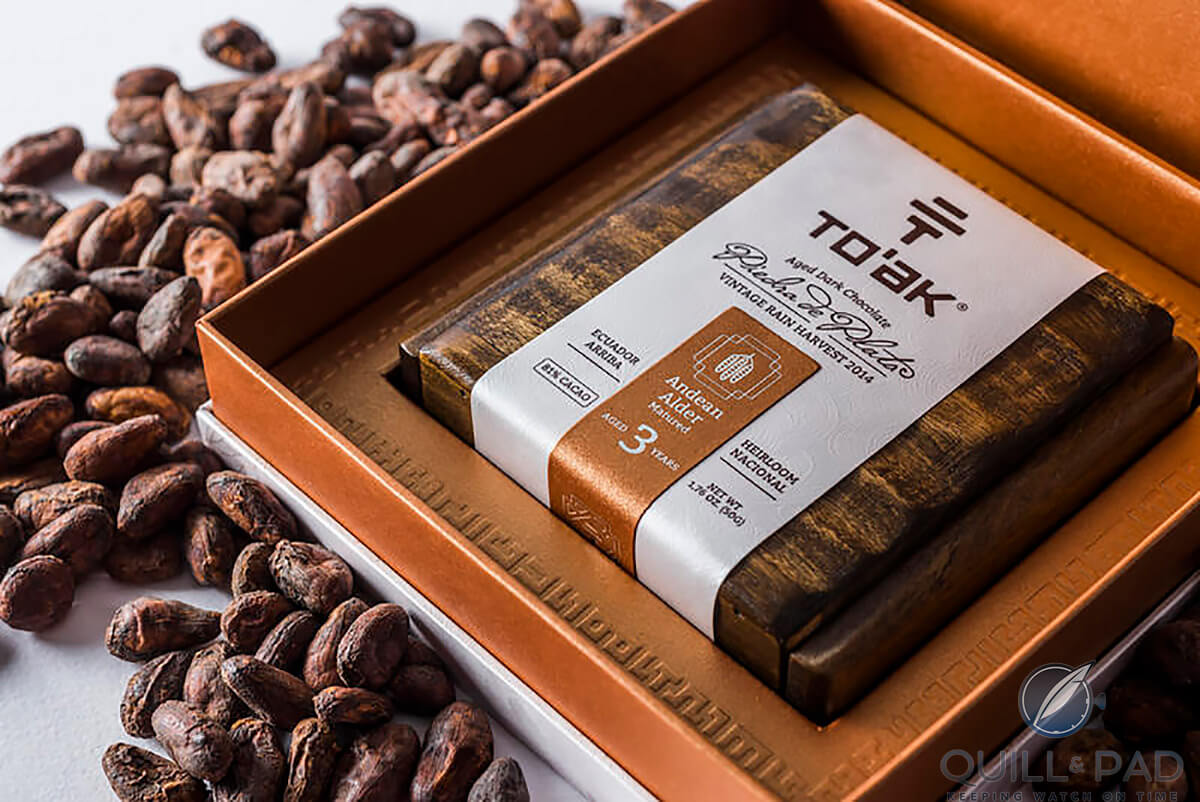
To’ak 2014 Vintage Andean Alder chocolate (photo courtesy To’ak)
Its use in the manufacture of chocolate provides for something rather unexpected. There is a maturity and sophistication here. Tobacco leaves, cedar, red fruits, spices, a hint of barbecued lamb, strong espresso, plums. A slight bitter-almond note on the finish (this is 81 percent), perhaps more so than with most of the To’ak chocolates.
There is even some grip. I can imagine coming in after an evening of winter fishing and relishing this chocolate. This is not your pretty sweetie. Cerebral chocolate, if ever there was one. Love it.
I know To’ak makes a chocolate that has spent considerable time in Islay casks (see above), but if I wanted to match this with anything, Laphroaig or Ardbeg do spring to mind.
4 Years Tequila Cask matured 3 years
Just as Don Julio Gonzalez revolutionized the tequila industry, so too has the team at To’ak changed the world of chocolate. It doesn’t hurt that the team at To’ak enjoys pairing its chocolate with Don Julio’s tequilas.
The collaboration extended to Don Julio sending three casks for To’ak to use for aging. The team experimented, light chocolate in one (73 percent) and a dark chocolate (80.5 percent) in another (nibs less successfully in the third).
The light chocolate picked up the flavors in a more concentrated manner. The result here was like a velvet crunch. Honeysuckle and caramel notes, while retaining freshness.
Rain Harvest 2015 Light
The aim here was to elevate the floral nature of the chocolate with this release, but there is also an array of fruit notes, tropical and red berries.
Some of that trademark caramel and honey is found here as well.
Rain Harvest 2017
The concept of vintage chocolate is something with which the world will have to come to grips. Bringing this chocolate closer to the concept of fine wine, the trees see no irrigation, so conditions will offer a strong influence.
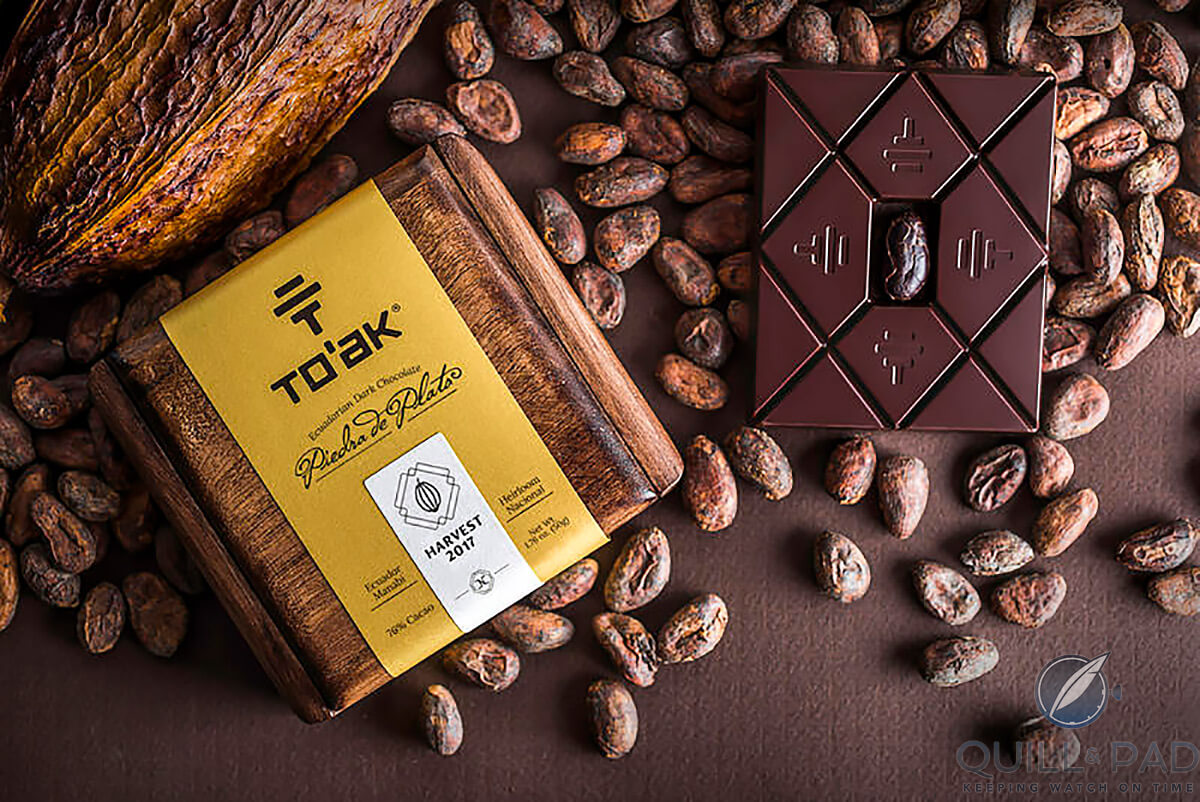
To’ak Rain Harvest 2017 chocolate (photo courtesy To’ak)
It would be a little pointless for me to attempt to identify what each vintage offers. Rather, simply enjoy the chocolate for what it offers. Here, a delightful nuttiness pervades. There is a subtle and gentle nature to this chocolate. A refreshing style, some red fruits, raspberries, even blackberries, make an appearance. Some nougat, dark coffee, and cranberries as well.
Rain Harvest 2016 El Niño
Predictions were dire for what El Niño would do to the cacao crop in 2016, but fortunately these proved unfounded. Florals and mint step up here.
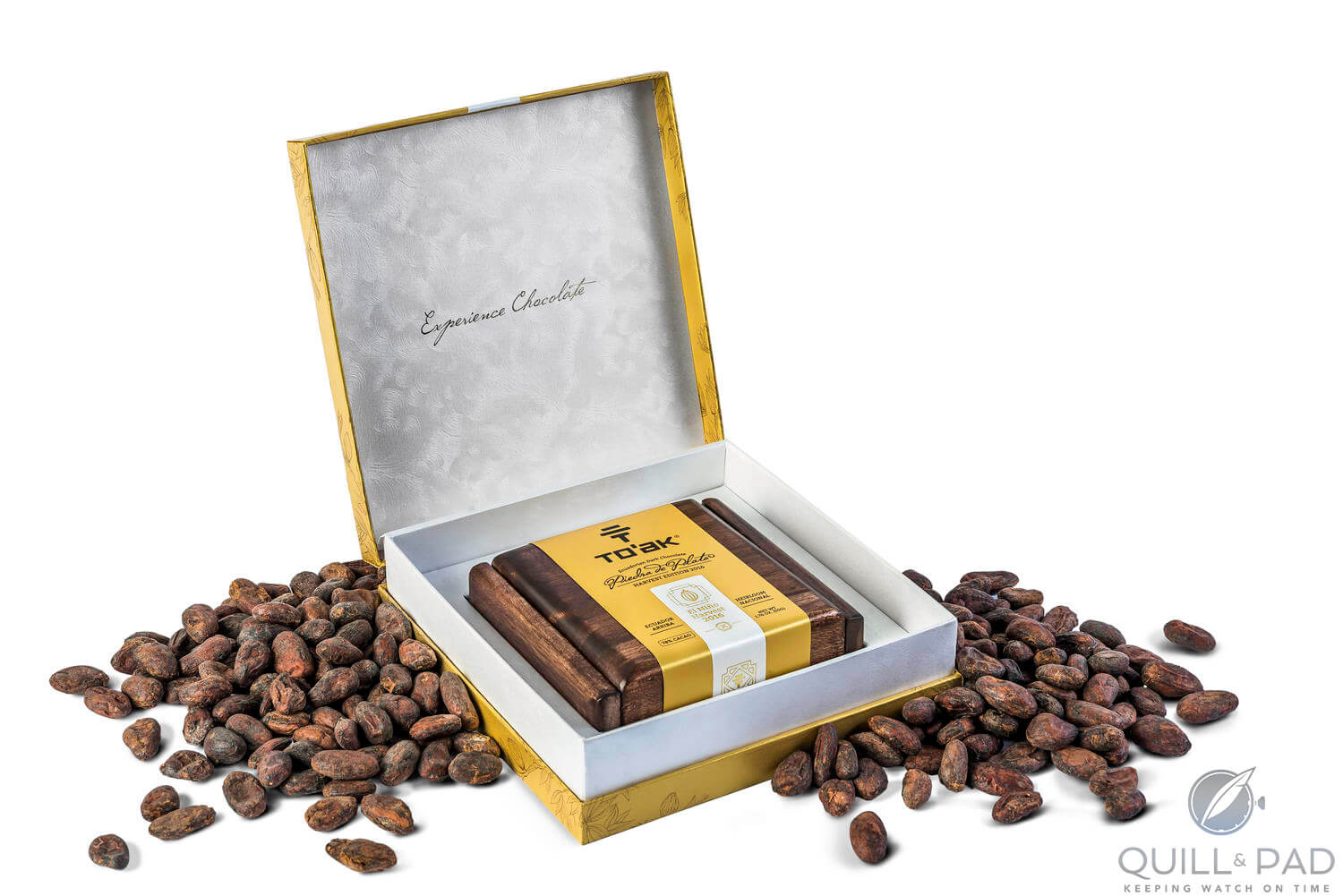
To’ak Rain Harvest 2016 El Niño chocolate (photo courtesy To’ak)
But honey and nuts and even a touch of a good cigar all make an appearance. Orange rinds. Immaculately balanced but exhibiting power and complexity.
Rain Harvest 2015 Dark
The team at To’ak has spoken of how it looks to a higher cacao percentage here, longer fermentation time, and relatively shorter conch time, which offers up florals, red fruits, and earthy notes.
These characters are what they see as the “signature flavor profile of the Nacional Cacao,” and it was this that encouraged them to start making chocolate. In addition, think dry herbs, wind-swept meadows, nuts, and honey.
Life might be like a box of chocolates but with To’ak, at the very least, you know you are certain to get chocolate of supreme quality.
For more information, please visit www.toakchocolate.com.
You may also enjoy:
The World’s Best Wine? No Contest: Romanée-Conti By Domaine De La Romanée-Conti
‘Agave’ (Get It?) My Heart To Tequila: A Brief History And Tasting Notes By A Very Recent Convert
Domaine Dujac: Red-Hot Burgundy Wines (With Tasting Notes)
Cloudburst: The Ultimate Unicorn Wine
Serra De Estrela Cheese: Rich, Ripe, And Full Of Intense, Tangy Flavors
Leave a Reply
Want to join the discussion?Feel free to contribute!



Such a great in depth look at quality chocolate. Thank you Ken for the enjoyable read and for highlighting the qualities of fine flavor Ecuadorian cacao.
Another promo article… The packaging is a gigantic waste and a turn off in itself. Embarrassing article because you support that waste. And you wrote: “basic milk chocolate needs only to be 10 percent (cocoa)”. I didn’t even know that there is a chocolate with such a low percentage available on this planet! Where is that? But it’s telling about your expertise. If “milk chocolate” with 10 percent cocoa would be my benchmark, I likely would be thrilled about that To’ak chocolate as well.
Hi Martin.
If, by “promo article”, you mean I am paid by the producer then I can assure that neither this, nor anything I have ever written for Quill and Pad qualifies as that (nothing I have ever written qualifies as that, with the exception of a few paid gigs to help out with copy for PR firms, but you would not know of that as my name is never attached to such items).
If, by “promo article”, you mean a piece on a product that I think is definitely worth featuring then guilty as charged.
You are correct in saying that I wrote “basic milk chocolate needs only to be 10 percent (cocoa)”. My understanding is that the regulations require that is the minimum (in case you are interested, i believe it is 12% for milk solids). To be honest, I also have no idea whether “there is a chocolate with such a low percentage available on this planet!” Just that there can be (I thought that was clear from the article but perhaps not). I suspect that some of the cheapest stuff might be of such low percentages, but we are not concerned about those here. So, as to where, I have no clue, but then if you had read the article a little more carefully, you would have realised that.
As for that being my benchmark, as you suggest, there is nothing in the article to support that at all. Again, even cursory reading of the article would have revealed that to you and such a suggestion is a complete concoction by you.
As for “packaging”, there is no question that their products are exquisitely presented. Hardwood boxes etc. You may find that to be a waste; others may disagree. I certainly did not find it a turn-off and I would suggest that any such claim is purely subjective. I did not focus on the presentation as I am more interested in the product itself. But if you are so concerned, I believe that they offer a more eco-friendly form of packaging.
I would agree that luxury products are often packaged in ways that might be considered wasteful. It is the way of things and there would definitely be less waste if that was not so. Whether that is the case here, up to the individual.
Untergang des abendlandes.
We might say the same thing about expensive mechanical watches, Jacob 🙂
Regards, Ian
Wow, you totally described how I felt tasting the To’ak Chocolate Islay cask release for the first time, well done!
For those who have never tried: don’t bash something just because it doesn’t align with your view of what chocolate should cost or look like. This is a whole different league of chocolate making. Most chocolate producers do not even know where the cacao beans they used came from!
Regarding packaging waste, they have less luxurious packaging for those who are not into the wooden box, but as stated on their website, all packaging materials are responsibly sourced. I believe they have elevated their packaging to an artwork, and since when is Art a waste of anything? I guess it is easy to criticize anything nowadays!
If you are truly worried about sustainability, I would rather buy from a company like To’ak who are planting cacao seedlings and working to save an ancient cacao species, instead of opting for the large conglomerates who are killing biodiversity but offer cheap chocolate or the many bean to bar vendors who have never taken trouble to even meet the farmer!
You have me even more curious to learn how it tastes, Daniel – I’ve ordered a couple of bars.
Regarding the packaging, we received this from To’ak: “We are careful about the sourcing of sustainable materials (wood, paper etc.) and not only does this provide local job opportunities in Ecuador, improve craftsmanship in a developing country (rather than Europe or China for example), but the amount of packaging “waste” is actually far less for one bar of To’ak chocolate versus the equivalent waste created from 200 mass-produced candy bars.”
Hi, Daniel. Thanks for those comments. It is a different experience.
Thank you Ken for a thoughtful and original piece and to Martín, Ian, Jacob, Daniel and others for contributing to the discussion. Your points open up interesting topics for exploration.
It’s often easy for us to be conditioned by prevailing norms in our society and not so easy to challenge our perceptions of what something can or should be. I’m confident that if anyone were to visit us in Ecuador and meet the farmers, then the value of a project like To’ak would be clear. Just like small European villages have thrived off of adding value to raw materials through tradition, unique terroir and craftsmanship, we are working with passionate Ecuadorian farmers and artisans to build a sense of value and pride in their rich culture and natural resources.
The right to make luxury goods or the right to consider something a fine food is not something that is exclusive to a particular region or country. It is born out of passion, talent and an appreciation for something truly unique and beautiful. Of course history has ensured this was a privilege of the West for some time. In our case we work and live in a country (Ecuador) that has the oldest evidence of any domestic use of cacao (some 5,300 years ago). The farmers we work with are working with us to protect the genetic diversity of heirloom cacao varieties that are in the brink of extinction. Part of the crisis Ecuadorian farmers and ecosystems face today are directly related to the mono crop varieties planted and required to produce the $1/€1 bars of chocolate that most consumers demand.
If we were facing a situation such as the imminent extinction of pinot noir grapes from France, I think many progressive, fine wine lovers, would be thrilled to support the protection of such a unique grape variety. Price would not be a topic of discussion because fine wine and European tradition is valued in our Western society.
Before the industrialisation of chocolate, cacao was actually considered very noble by the Aztecs, Mayans, Incas and many other cultures. They understood its rich nutritional, energetic and psychoactive properties. In fact when it first arrived in Europe it was the ultimate definition of a luxury good.
It doesn’t take a $200 bar of chocolate to make the chocolate value chain fair but we are not producing a chocolate bar. We are reimagining a tired old system (mass produced cheap chocolate) that only extracts value from the south (paying farmers below a living wage) and we are proud to inspire other Ecuadorian brands with an alternative path towards more conscious business.
For anyone that is interested to learn about our efforts to go beyond simple tag lines or certification labels, we share some of our efforts in this blog post: https://toakchocolate.com/blogs/news/social-environmental-impact
Our blog also covers the conservation work we do.
Thank you once again for the opportunity to contribute to this interesting topic. Best regards, James Le Compte (CEO and partner at To’ak)
Hi James. thanks for that terrific response.
As mentioned, I did not go into the packaging to any extent but of course, we have seen ever increasingly ornate packaging in spirits and champagnes. We are seeing it in cigars – look at the new boxes for Limited Editions. Less so wines.
I would have loved to have had a much deeper look into the conservation efforts, which are really impressive, but one does have to draw the line somewhere. Anyone interested in that should definitely have a look.
thanks again.